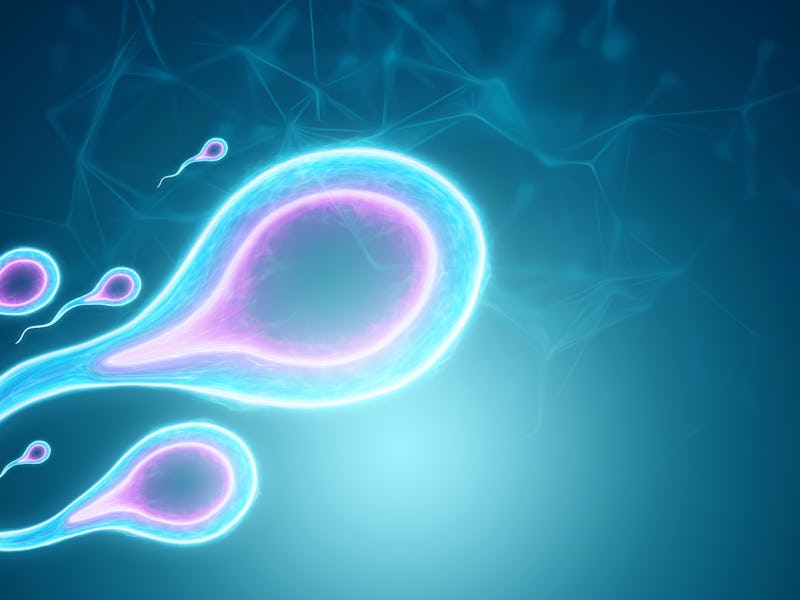A new sperm discovery could help solve two huge male fertility issues
These seemingly opposing issues may be two sides of the same coin.

It’s rare that a problem’s cause can also be its solution. However, this is the case with a recent discovery that involves sperm, infertility, and male contraceptives.
On one side of the coin is the problem of sperm being able to swim to an egg and fertilize it. On the other side is the near-total lack of a male contraceptive that could help prevent unwanted pregnancy.
A key to both curing infertility and preventing pregnancy? The SPATA33 gene.
A study in mice published Thursday in the journal Proceedings of the National Academy of Sciences shows that whether or not mice carry this gene appears critical to regulating sperm motility. In other words, the measure of how well they’re able to move so they can wriggle on over to the ovum.
What’s new — The results suggest the SPATA33 gene could solve a problem with male contraceptive treatments — and hints at a way to also treat infertility. Sperm produced with this nonfunctioning gene have a rigid part of their tail, so they can’t swim well.
“The function of SPATA33 was unknown until now,” lead author Haruhiko Miyata tells Inverse. Miyata is a researcher at Osaka University.
“We found that SPATA33 is important for sperm motility and male fertility,” he explains.
The problem researchers are trying to solve is to do with the protein calcineurin, which also affects sperm motility. In the past, this protein has been a target for male contraceptives and calcineurin inhibitors can cause temporary, fully reversible, infertility in mice.
Calcineurin also plays a role in the immune system so a drug that inhibits the protein can affect immunity. By “turning off” the gene that regulates sperm’s motility — and only that function — instead means there’s no messing with the immune system and researchers get the same desired effect: infertility.
How they did it — There are about 20,000 proteins in mice, and Miyata and his team used a database to select candidate proteins for testing.
“We were surprised when we really found the protein, SPATA33, that interacts with calcineurin,” Miyata says. He calls that the “eureka moment.”
Miyata and colleagues used gene editing to knock out the SPATA33 in male mice. The scientists refer to these mice as “SPATA33 knockout mice.”
The SPATA33 knockout mice have sperm that looked just like other gene-edited mice that instead did not have any calcineurin. In other words, these scientists had discovered the gene that regulates the calcineurin protein only in sperm and not everywhere else in the body.
One day men may be able to take a birth-control pill.
Why it matters — The conversation about male contraceptives has been going on for decades Part of the issue with making these ideas reality comes from figuring out how to make an effective drug that men will actually want to take and that is safe. The Guttmacher Institute found that between 2015 and 2019, 120 million unwanted pregnancies occurred each year worldwide.
Likewise, male infertility can plague families and cause emotional distress. Of heterosexual couples trying to conceive, 10 percent of the males in those couples suffer infertility. Sometimes treatment is as easy as making lifestyle adjustments to diet or substance use. But in 50 percent of male infertility cases, the cause cannot be determined. But this discovery could also treat male infertility.
By understanding both the gene and protein that control sperm motility, researchers can then investigate how to “turn on” that gene or ramp up its activity where it’s lacking. Infertility can be caused by a number of factors, but understanding the gene that produces good swimmers is one prong to the treatment approach.
What’s next — But before there’s another pill on the market, more work must be done.
The researchers still don’t know what the relationship between SPATA33 and calcineurin is exactly. Part of that is to do with a knowledge gap on calcineurin and the role of the protein in the body as a whole.
“We also would like to clarify how SPATA33/calcineurin regulates sperm motility,” Miyata says.
The study team also wants to find a specific inhibitor of SPATA33, which “may lead to the development of an oral pill for men that works in a short period of time,” he says.
This study is preliminary, but it is an exciting step on the road to both curing male infertility and enabling male contraceptives.
Abstract: Calcineurin is a calcium-dependent phosphatase that plays roles in a variety of biological processes including immune responses. In spermatozoa, there is a testis-enriched calcineurin composed of PPP3CC and PPP3R2 (sperm calcineurin) that is essential for sperm motility and male fertility. Because sperm calcineurin has been proposed as a target for reversible male contraceptives, identifying proteins that interact with sperm calcineurin widens the choice for developing specific inhibitors. Here, by screening the calcineurin-interacting PxIxIT consensus motif in silico and analyzing the function of candidate proteins through the generation of gene-modified mice, we discovered that SPATA33 interacts with sperm calcineurin via a PQIIIT sequence. Spata33 knockout mice exhibit reduced sperm motility because of an inflexible midpiece, leading to impaired male fertility, which phenocopies Ppp3cc and Ppp3r2 knockout mice. Further analysis reveals that sperm calcineurin disappears from the mitochondria in the Spata33 knockout testis. In addition, immunoprecipitation analysis indicates that sperm calcineurin interacts with not only SPATA33 but also the mitochondrial protein VDAC2. These results indicate that SPATA33 localizes calcineurin to the mitochondria and regulates sperm motility.